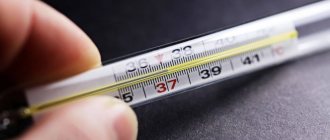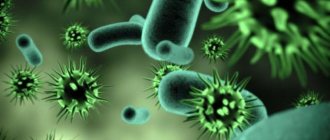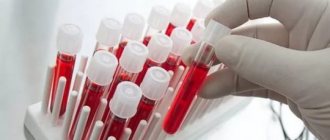Average reading time: 8 minutes
Publication date: August 09, 2021
Zakharova Carolina Yurievna
Physician and author of scientific articles on therapy, ophthalmology, pediatrics and psychiatry
The mark “37” on the thermometer can cause many questions. Should I be worried or is this normal? Or maybe it’s time to take antipyretics? Let's figure out what causes a slight fever and what should be done.
Up to contents
Signs of a high fever
The following signs (symptoms) may indicate that the temperature is rising:
- a feeling of weakness, sudden fatigue, a general painful state;
- chills (mild chills at slightly elevated temperatures and severe chills at high temperatures);
- dry skin and lips;
- headache, body aches;
- loss of appetite;
- sweating (“breaks into a sweat”);
- arrhythmia.
If you are experiencing any of these symptoms, it would be a good idea to take a thermometer.
Rinza
Rinza tablets are a complex drug. The product contains caffeine, which enhances the antipyretic effect and improves metabolic processes. Paracetamol helps reduce fever and relieve muscle pain. Phenylephrine relieves swelling of the nasal mucosa, chlorphenamine is an antihistamine against inflammation. "Rinza" relieves cold symptoms for 12 hours. This drug is contraindicated for pregnant women, hypertensive patients, patients with atherosclerosis, those treated with antidepressants, people with kidney and liver diseases; alcohol should not be taken while being treated with Rinza.
Rinza
Unique Pharmaceutical Laboratories, India
- symptomatic treatment of “colds”, acute respiratory viral infections (including influenza), accompanied by fever, pain, and rhinorrhea.
from 64
665
- Like
- Write a review
What is considered a high temperature?
Normal temperature is generally considered to be 36.6°C. But in fact, temperatures within a fairly wide range are normal.
During the day, body temperature fluctuates quite a bit. The lowest temperature is observed in the morning, immediately after waking up; maximum - in the evening, at the end of the day. The difference can be somewhere around 0.5°C. Physical activity, stress, ordinary meals, drinking alcohol, staying in a bathhouse or on the beach can raise the temperature. In women, temperature fluctuations are also associated with ovulation. A few days before ovulation, the temperature decreases, and when ovulation occurs, it increases.
On average, a normal temperature is considered to be between 35° and 37°C. In children under 3 years of age, a temperature of up to 37.5°C is also considered normal. Where you take your temperature matters. You can focus on 36.6°C if you place a thermometer under your arm. If the thermometer is held in the mouth ( oral temperature
), then the normal temperature will be 0.5°C higher (36.8-37.3°C).
In order to obtain normal values when measuring the temperature in the rectum ( rectal temperature
), you will need to add another half a degree (the norm is 37.3-37.7 ° C). Based on the measurement of the temperature under the arm, an elevated temperature is a temperature in the range of 37-38°C, a high temperature is above 38°C.
Worrying is either a temperature that rises above 38°C or a temperature of up to 38°C that persists for a long time ( low-grade fever
).
Aspirin
Aspirin can be bought both in regular tablets and in effervescent form. This is an NSAID whose active substance is acetylsalicylic acid. Aspirin has a strong antipyretic effect, it is an excellent pain reliever, while the anti-inflammatory effect of the drug is very weak. After taking Aspirin, relief occurs within 15 minutes (faster if these are effervescent tablets). But you need to remember that Aspirin is not the safest drug for fever. Allergies often occur to it; asthmatics, allergy sufferers and those who have problems with the gastrointestinal tract and liver should not drink it. It is prohibited for children under 15 years of age and pregnant women to take Aspirin with alcohol.
Aspirin
When is an increase in temperature dangerous?
High body temperature is an undoubted sign that some pathological process, usually of an inflammatory nature, is developing in the body. The higher the temperature, the faster it rises or the longer it lasts, the more serious the problem that caused it may be. This is why high temperatures are scary.
Meanwhile, in itself, an increase in temperature in most cases is a protective reaction to the penetration of infection. At high temperatures, the activity of pathogenic microorganisms decreases, and the body’s defenses, on the contrary, intensify: metabolism and blood circulation accelerate, and antibodies are released faster. But this increases the load on many organs and systems: cardiovascular, respiratory. High temperature depresses the nervous system and leads to dehydration. Possible circulatory disorders in internal organs (due to increased viscosity and blood clotting). Therefore, a high temperature that lasts for a long time can pose a danger in itself. Extremely high temperatures (above 41°C) are also dangerous.
Theraflu ExtraTab
These fever tablets contain paracetamol, which reduces fever well. In addition, Theraflu ExtraTab contains phenylephrine (a vasoconstrictor) and chlorphenamine (an antihistamine). Therefore, the drug has a complex effect - it relieves swelling during a runny nose and reduces fever. Contraindications to taking Theraflu ExtraTab include stomach ulcers.
Theraflu extratab
Novartis Pharma Services AG (Novartis Pharma), Switzerland
Symptomatic treatment of infectious and inflammatory diseases (ARVI, including influenza), accompanied by high fever, chills, headache, runny nose, nasal congestion, sneezing, muscle pain.
from 148
368
- Like
- Write a review
Should I lower the temperature or not?
There is no need to rush to lower the temperature. First of all, the patient must be examined by a doctor. You should follow the doctor’s recommendations: if he advises you to lower your temperature, then you should lower it. The doctor makes decisions based on the general picture of the disease and assessment of the patient’s condition, that is, recommendations are always individual.
However, if the patient has a severe fever and the temperature is high (39°C or higher), then he can be given an antipyretic drug, strictly following the instructions on the package. At the same time, you need to understand that you are fighting a symptom, not a disease.
The correct course of treatment involves identifying the cause of the high temperature and carrying out a set of measures aimed at treating the disease that caused its increase.
Symptom treatment
To figure out how to bring down the temperature, you need a correct diagnosis. An experienced doctor, based on the results of tests and studies, determines the cause of the fever, prescribes medications, procedures, or refers to a specialist for additional research. The goal is to identify the source of the inflammatory process in order to find the right treatment complex. Treatment for high fever depends entirely on the underlying cause and may include antipyretics, antibiotics, probiotics, etc.
Symptom during pregnancy
The temperature in pregnant women rises above the normal limit due to acute respiratory viral infections and influenza. It can harm the baby, especially if the mother takes medications containing aspirin. Therefore, pregnant women with fever need urgent consultation with a doctor to prescribe the correct dose of medications. If the temperature jump is small, you can take homeopathic remedies prescribed by your doctor.
Along with the tablets in the 1st trimester, you can drink herbal teas, fruit drinks, compotes, and juices. At later stages, drink concentrated herbal infusions, which are not consumed in large quantities to avoid swelling. Decoctions of leaves, raspberries, coltsfoot, plantain, and infusion of white willow bark have healing properties. Rubbing with a vinegar solution helps.
Treatment at home
If you find cold symptoms and a temperature above 37°C and weakness, you can start taking home remedies to support the body. If the value on the thermometer does not exceed 38.5°C and the body feels more or less well, there is no need to lower the temperature. At this time, harmful bacteria die, and the immune system works at full capacity.
However, if the patient’s condition is serious, he does not tolerate the temperature well, it needs to be brought down. At 40°C the blood begins to thicken and coagulate, so you should take antipyretics. In order not to cause negative effects on internal organs, many patients prefer folk remedies with a mild effect.
Folk remedies for fever for children:
- children's enemas with a soda solution (1 tsp of soda for 1 glass of water) or chamomile decoction;
- wipe the child’s body with green grape juice;
- put on socks moistened with a solution of water and vinegar in a 1:1 dilution for 15 minutes;
- Infants and children under 3 years of age can be briefly wrapped in a wet sheet or towel to relieve the condition.
If the temperature is 39°C or 40°C in adults, it must be brought down:
- wiping and a cold compress - a cotton cloth is moistened with water at room temperature or a solution of water and vinegar;
- drinking plenty of fluids - it is necessary to prevent dehydration of the body by taking drinking water, freshly squeezed juices or warm herbal infusions, honey water (1 tsp of honey for 1 glass of warm water);
- fasting - give the body a rest (food is a load), concentrate energy on fighting inflammation.
Causes of high temperature
Any inflammatory process can cause an increase in temperature. The nature of inflammation can be different - bacterial, viral, fungal. In most cases, the temperature is a concomitant symptom: for example, with otitis media, the ear hurts (“twitches”) and the temperature is elevated...
Temperature attracts special attention when no other symptoms are observed. Temperature against the background of standard signs of ARVI is ordinary, but only one high temperature is frightening.
Diseases that may cause a high fever without other symptoms
:
- ARVI and influenza. Flu, and in some cases other acute respiratory viral infections, can begin with a sudden rise in temperature. In this case, catarrhal symptoms begin somewhat later (in the late afternoon or the next day);
- angina. Along with fever, there is usually a sore throat when swallowing. The pain in the throat intensifies quite quickly, so that it cannot be ignored;
- chickenpox (chickenpox). The typical onset of chickenpox is high fever. Characteristic rashes may appear only on the 2-3rd day of illness;
- abscess (accumulation of pus in superficial tissues or internal organs). With an abscess, the temperature “floats”: temperature peaks can be interspersed with normal temperature during the day (in contrast to the typical temperature schedule for an “ordinary” infectious disease - when the lowest temperature is observed after waking up in the morning, and rises in the evening);
- inflammations of the genitourinary system (pyelonephritis, glomerulonephritis) are usually manifested by high fever and pain in the projection of the kidneys. But in some cases there may be no pain;
- appendicitis - can also occur without pain;
- meningitis and encephalitis (inflammation of the meninges of infectious origin). In this case, high temperature is accompanied by severe headache, nausea, and blurred vision. A characteristic symptom is tension in the neck muscles (the chin cannot be lowered to the chest);
- hemorrhagic fever (usually infection occurs through the bite of wild animals, for example, a field mouse). This also has its own characteristic symptoms - a decrease (even cessation) of urination, the appearance of subcutaneous hemorrhages (spotted redness of the skin, rash), muscle pain.
Elevated temperature (up to 37.5-38°C) without pronounced other symptoms
may be observed with:
- tuberculosis;
- oncological diseases;
- diseases of the thyroid gland (thyrotoxicosis);
- neurological disorders;
- allergic reaction (this is how individual intolerance to medications may manifest itself).
The following diseases also occur with an increase in temperature:
- inflammation of the lungs (pneumonia). Pneumonia is a common cause of high fever. In this case, chest pain, shortness of breath, and cough are usually observed;
- infectious diseases of the gastrointestinal tract (gastroenterocolitis). Here temperature is a side symptom. Main complaints: abdominal pain, diarrhea, nausea, vomiting;
- viral hepatitis A, which is characterized by the appearance of a jaundiced coloration of the skin and whites of the eyes;
- other viral diseases - measles, rubella, mumps (mumps), mononucleosis, polio, etc.;
- chronic diseases of the urinary system (chronic pyelonephritis, cystitis), in women - chronic salpingoopharitis. Along with low-grade fever, abdominal pain and urination problems may occur;
- sexually transmitted diseases (gonorrhea, syphilis, urogenital infections - toxoplasmosis, trichomoniasis, ureaplasmosis, etc.);
- chronic myocarditis and endocarditis. In this case, the usual symptom is pain in the heart area;
- autoimmune diseases (rheumatism, systemic lupus erythematosus, etc.).
This, of course, is not a complete list of diseases that can cause fever
And yet, what diseases can cause low-grade fever?
An increase in temperature to 37–37.5°C can be a symptom of a number of difficult to diagnose diseases. Here are some of them:
- sluggish local and general inflammatory processes in the body;
- pneumonia (pneumonia);
- chronic tonsillitis (inflammation of the palatine and pharyngeal tonsils);
- hepatitis;
- tuberculosis;
- HIV AIDS;
- chronic pyelonephritis (inflammation of the kidneys);
- dysfunction of the cardiovascular system;
- ulcerative colitis, gastritis (inflammation in the gastrointestinal tract);
- toxoplasmosis, herpes, other TORCH infections;
- allergic reactions;
- malignant tumors (oncology);
- thyrotoxicosis (increased production of thyroid hormones);
- helminthic infestations or the presence of other parasites in the body;
- anemia.
Diagnosing a disease when the only symptom is low-grade fever is difficult. (Editor’s note: in the scientific article “Fever of unknown origin,” a group of medical specialists explains in detail why it is difficult to establish a diagnosis and what studies may be required to determine the cause of an increase in temperature to 37‒37.5 ° C).
High temperature in a child
The child will not say that he has a high temperature. Even relatively older children, including students in elementary school, as a rule, cannot correctly assess their well-being. Therefore, parents need to closely monitor the child’s condition. You can suspect an increase in temperature based on the following signs:
- the child becomes unexpectedly lethargic or, conversely, restless and capricious;
- he is tormented by thirst (he asks for a drink all the time);
- mucous membranes become dry (dry lips, tongue);
- bright blush or, conversely, unusual pallor;
- eyes become red or shiny;
- the child is sweating;
- pulse and breathing increase. The normal heart rate is 100-130 beats per minute while sleeping and 140-160 while awake. By two years, the frequency decreases to 100-140 beats per minute. The normal breathing rate also depends on age; for a two-month-old child it is 35-48 breaths per minute, for an age from one to three 28-35 breaths.
You can measure body temperature in the armpit or groin cavity with a mercury thermometer (it most accurately shows the temperature), rectally - only with an electronic one. It is possible to measure the temperature rectally only in a small child (up to 4-5 months); older children resist the procedure, as it is unpleasant. To measure the temperature rectally, the tip of the thermometer is lubricated with baby cream, the child’s legs rise, as if washing. The tip of the thermometer is inserted into the rectum to a depth of 2 cm.
We should not forget that in children under one year of age, a normal temperature is considered to be a temperature of up to 37.5°C, and even up to 3 years of age, such a temperature does not always mean that the child is sick. You cannot measure the temperature when the child is very worried, crying, or is tightly wrapped up - the temperature in these cases will be expected to be higher. A hot bath or too high a room temperature can also increase your body temperature.
In young children, the temperature can rise up to 38.3°C for reasons unrelated to illness, such as:
- overheating (due to excessive wrapping, exposure to direct sunlight or poor drinking habits), especially before the age of 3 months;
- scream;
- constipation (if the child pushes, the temperature may rise);
- teething (one of the most common causes).
If it does not seem that the temperature is caused by one of these reasons, it persists and does not subside, or, moreover, increases, it is necessary to urgently consult a doctor. If the temperature is above 38°C, you should consult a doctor in any case.
Pathological conditions
If a person’s temperature rises to 37 in the evening, this may be an alarm bell. There are many pathological causes for this condition, but they all usually have additional symptoms. Busy people leading an active lifestyle may not even notice them.
Colds
The most common symptom of a cold is an increase in temperature. In this way, the human body tries to cope with the infectious agent. It is known that viruses die when the thermometer reaches 38 degrees. Therefore, you should not lower your temperature to 37. Allow your body to eliminate the infection on its own and build immunity.
Consequences of infection
Many infectious diseases occur with elevated temperature. But what if you are already healthy and it still continues to rise? This outcome is also possible. It is in the evening that the thermometer increases noticeably.
Such symptoms are especially common due to chickenpox, acute intestinal infection, and bacterial pathologies. Don't worry, your body will regain its strength in the near future. Such temperature indicators do not require the use of antipyretics. After a night's rest, they return to normal on their own.
Arterial pressure
Hypertensive patients often complain that they have an elevated body temperature. Such a natural consequence of high blood pressure cannot be called natural, but it is not entirely correct to consider it pathological. As soon as the patient brings the blood pressure back to normal, the thermometer shows lower numbers.
Hypotonics, on the contrary, have a low body temperature. For some people it drops to 36 degrees. It is very important not to miss the moment. But if this condition does not cause discomfort, then there is no need to try to correct it.
You will also be interested in:
- Temperature 37-38 and low pressure - causes and treatment
VSD
This abbreviation stands for vegetative-vascular dystonia. Until now, this disease remains incompletely studied.
Many doctors refute it, saying that the person is dealing with chronic fatigue syndrome. One way or another, with vegetative-vascular dystonia, the thermometer readings increase. A person may note that in the morning the temperature is 36, in the evening – 37.
Oncological pathologies
It is the evening increase in thermometer values that often forces a person to turn to specialists. During the examination, tumor processes may be detected.
Benign neoplasms often do not make themselves felt with such symptoms. But the proliferation of cancer cells affects the lymphatic system, so a slight increase in the readings of the mercury meter is the first alarm bell.
Immune diseases
Any deviations in the functioning of the immune system and protective functions of the body affect temperature values. They become higher with the following pathologies:
- allergy;
- rheumatic diseases;
- blood pathologies;
- system deviations.
Many diseases develop due to increased immune function of the body, which provokes inflammation of various types.
Low blood glucose
Hypoglycemia due to prolonged hunger and excess insulin provokes energy starvation of the brain, slows blood circulation and metabolism. As a result of glucose deficiency, physical weakness develops, dizziness, and attacks of hunger. With a prolonged lack of sugar in the blood, coordination of movements is impaired, asthenia sets in, the body breaks out in cold sweat, and body temperature drops to +35°C. In the absence of outside help to the body, fainting and hypoglycemic coma are possible. People of any age are susceptible to pathology; insulin-dependent patients suffer more often than others.
Help with hypothermia
Immediate measures: exposure to heat, elimination of hunger, neutralization of toxins. A person with hypothermia is advised to drink hot tea, take a bath, and wrap himself in a thick blanket. In critical conditions, hospitalization is required.
The exact causes of the pathological symptom are determined by the therapist or doctors of other profiles. Diagnostics includes biochemical and hormonal blood tests, ECG, ultrasound of internal organs, computed tomography or MRI of the spine and brain. A complete medical examination helps to identify the most unexpected causes of low temperature.
Drug therapy depends on the established diagnosis. These can be antibiotics, immunomodulators, antidepressants, nootropics. To consolidate the results of treatment, the doctor usually recommends purchasing vitamin and mineral complexes.








